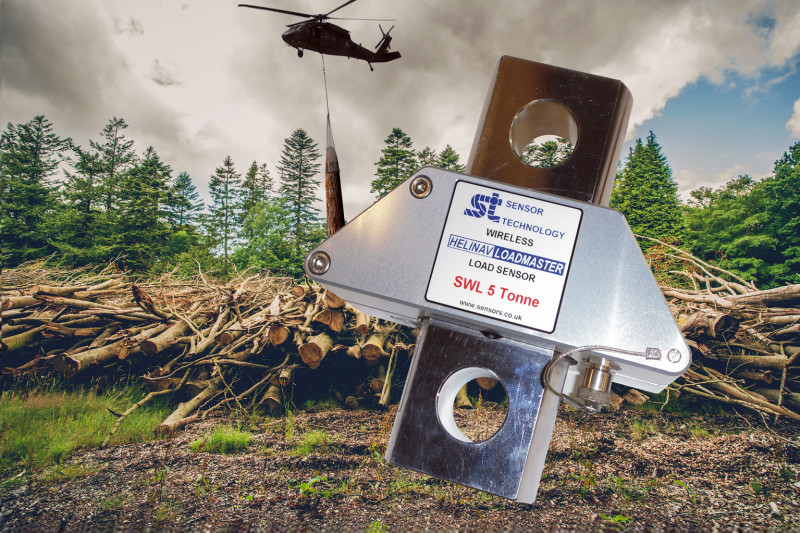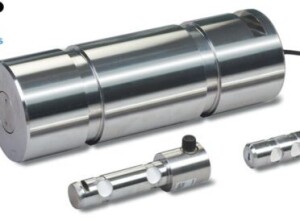Sensor Technology Ltd (UK) - Innovative wireless load sensing and monitoring technology from Sensor Technology is playing a key role in helping a helicopter services company to pluck trees from forests where there is no access by tractor.
Based in Oxford, Heli-Lift Services provides a unique helicopter-based extraction service in forests where the ground is wet or boggy, or in environmentally sensitive expanses and areas of special interest, ensuring minimal disruption to the environment. With these services, the company is meeting the tree extraction requirements of everything from thinning and commercial timber supply, to the plucking of Christmas trees for delivery to towns and cities around the country.
The key to the company’s ability to ensure that its operations are safe and have a wealth of data upon which to base its maintenance and billing is the HeliNav TrackMaster sensing system from Sensor Technology that incorporates a strain gauge into the cargo hook that carries the helicopter’s under-slung load.
The wireless Load Sensor is a strain gauge based stainless steel tension type sensor. It has the capability of wirelessly transmitting its data to a readout where it both displays live readings and records them to build up an exact profile of each operation.
Its inbuilt 32MBit memory can hold up to 280 hours of data which can then be downloaded to a PC via its USB cable. The Load Sensor transmits using the worldwide licence-free frequency of 2.4GHz using two built in antennae.
The readouts can be cockpit mounted for the pilot’s use or handheld by an assistant on the ground (in fact, signals can even be transmitted to multiple control units simultaneously). The complete system is entirely autonomous, making it independent of the helicopter’s control systems, while being wireless means it does not require additional certification of the electrical systems. It also means it can be swapped from one helicopter to another, allowing a small number of systems to be shared around a fleet of helicopters.
Heli-Lift Services has developed a close working relationship with Sensor Technology, and the HeliNav TrackMaster has proved an important tool for the helicopter operator in its forestry extraction tasks. Trees that have been felled by chainsaw are fitted with a harness, attached to the waiting helicopter, and then lifted out to a waiting truck with no risk of any ground damage.
This is a challenging operation for the helicopter pilot. The tree is suspended on a 100ft line, and the pilot has to hover over the tree while the harness is attached, and then lift it straight up without risk of damage to other trees. Time is also of the essence, as the helicopter has to set down for refuelling every 40 minutes.
At the same time, it is important for the operator to keep a track on the total weight lifted and to monitor the strain on the harness cables – not simply to ensure the weight of the tree does not exceed the capacity of the lifting rig and the helicopter, but also so that the aggregate strain over time is known so that maintenance can be scheduled and cables can be replaced before their operational duty limits are reached.
There are commercial considerations, too. Billing is based on the weight of the load and the distance travelled, so the helicopter operator needs to provide the client with accurate work reports and precise billing. In the cockpit, the HeliNav TrackMaster controller accurately logs the weight of the load and also the distance travelled. The controller also uses an on-board GPS (global positioning system), inclinometer and accelerometer to help plot flight paths, flight times, fuel requirements, etc.
For Heli-Lift Services, where once the company’s billing and maintenance was based on time charges and estimations of loads, it now has full operational data for precise loads and exactly what distances have been flown.
Removing trees from forests, whether for thinning to improve the growth rate or health of the remaining trees, or because the forests have been designed to provide a sustainable source of wood, is rarely a straightforward business. In an ideal world you’d simply fell the tree and tow it out of the forest with a tractor. But in situations where the ground is wet or boggy, or in environmentally sensitive expanses and areas of special interest, often access for a tractor simply isn’t possible. In such cases, the only alternative is to lift the tree out by helicopter.
Sustainable forestry is about much more than simply letting the trees get on with it. Optimising the growth rate and health of the trees is a science in itself. Overcrowded trees are under competitive stress from neighbours, and thinning is thought to increase the resistance of stands to environmental stresses such as drought, insect infestation and extreme temperature. At the same time, thinning can be important for increasing biodiversity in the forest.
In commercial forestry operations, thinning might mean removing the trees that have little economic value in order to give the remaining trees the best opportunity to thrive. Further, it can accelerate the development of desired structural attributes such as large trunk diameters and long tree crowns.
Then of course there is the removal of trees for economic reasons, with many forests established to provide a sustainable supply of timber, or for the seasonal supply of Christmas trees to towns and cities around the country.
In all of these applications, Heli-Lift Services is playing an important role in the safe, efficient and environmentally friendly extraction of trees from forests, aided by the Sensor Technology HeliNav TrackMaster which has proven its worth through hundreds of lifts. Indeed, throughout November and December Heli-Lift Services has been particularly busy, extracting Christmas trees from Kielder forest in Northumberland for delivery to city centres, civic amenities, etc.
With no access for a tractor, Heli-Lift Services has plucked over 130 trees from the forest of Norwegian Spruce trees. Managed by Elveden Farms which delivers more than 900 trees to towns and cities every year, Kielder forest is one of the UK’s leading sustainable sources of Christmas trees.
























Interested? Submit your enquiry using the form below:
Only available for registered users. Sign In to your account or register here.